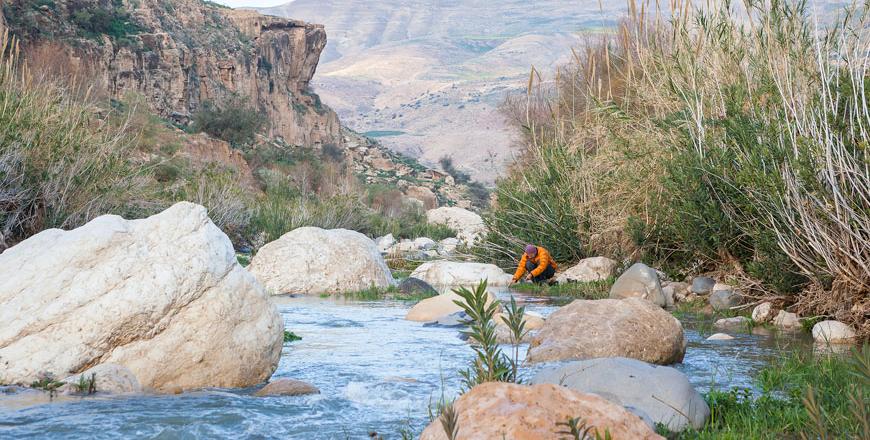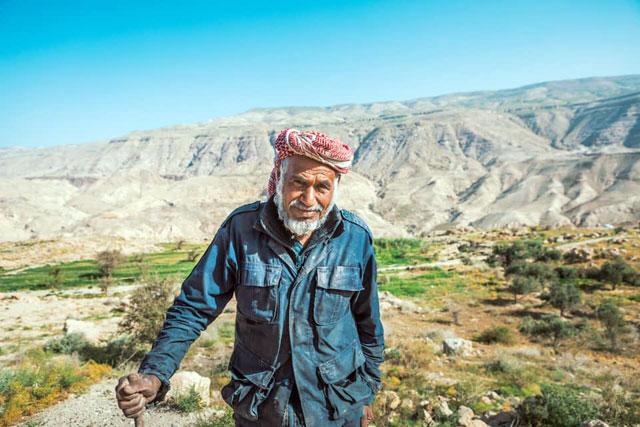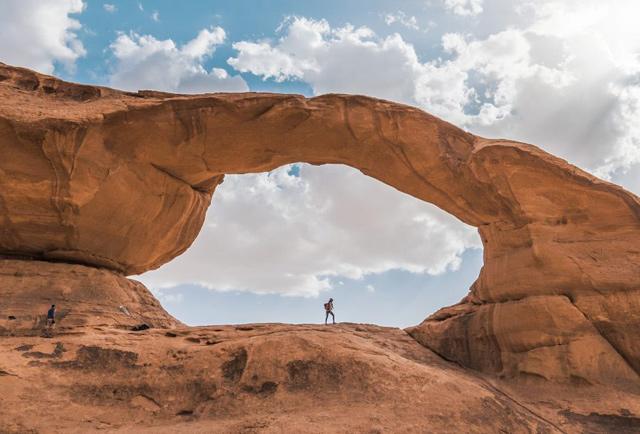You are here
Volunteers working to provide tourists, locals with access to 600km trail, from north to south
By Dana Al Emam - Apr 09,2016 - Last updated at Apr 10,2016

In this undated photo, a hiker is seen in Wadi Al Heedan in Madaba Governorate, which lies on a hike trail volunteers are working to open for experiential tourists (Photo courtesy of Jordan Trail Association)
AMMAN — In a bid to encourage experiential tourism, the Jordan Trail Association (JTA) has developed a hiking trek that connects Um Qais in the northern tip of the country to the Red Sea resort of Aqaba, passing through areas with distinctive features.
Founded by a group of volunteers in July 2015, the association seeks to make the 600-kilometere-long trail a national product that brings to light and encourage visits to less discovered areas, the association's president, Muna Haddad, told The Jordan Times in a recent interview.
The main task of the association is opening up the hiking trail, and making it more accessible to tour companies and tour guides, as well as individual hikers, she said, noting that guided trips are recommended for inexperienced hikers as the trail is not way-marked yet.
Through the association's website, hikers can download GPS coordinates for their planned hike, and get in touch with the guides and the local communities in the area.
The trail passes through various villages and badia regions with unique dishes, famous juices and traditions, a matter that enriches the experience of hikers who interact with the local communities, said trail manager and JTA co-founder Amjad Shahrour.
"You start in the greener part of Jordan in the north, Um Qais, Ajloun and all the forests, and then you go down to all the Wadis and the dramatic scenery in Wadi Mujib, Wadi Zarqa and Wadi Hedan. Then you move to the south’s deserts passing Petra and Wadi Rum," he said.
Signing up for a trip through the tour operators is not only a fun activity, but it also gives the hiker a chance to disconnect from the daily routine.
"You do not always spend time with people; in some remote sections of the trail you don't see people for days, such as the section from Petra to Humaima," he said.
Although the entire trail takes around 40 days to finish, people can go on short one-day hikes or two or three-day stretches, Haddad said, adding that "very few" people end up doing the whole trail.
There are long distance trails all around the world and trail hiking is becoming a popular activity around the globe, therefore the association finds it "important" for Jordan to be part of that scene.
"It is an opportunity for people to go out, enjoy the outdoors and do physical activity while engaging in the nature and culture of Jordan," she said, adding that future plans include opening up the trail further and way-marking it, making it easier to get to for non-hikers who are trying it out for the first time.
Hikers interact with the local communities in some 52 villages and engage with them along the trail for purposes like eating, drinking and having a place to stay, according to Haddad.
"It is important for us to highlight these unique localities among the Jordanian cultural fabric from north to south as well as some of the remote areas and archaeological sites that are less discovered and less known," she said.
As the situation of international tourism in generally not doing very well in the region, the trail is an opportunity for Jordanians to explore their country and support the local communities along the trail.
"There is such a big rise in responsible tourism… travellers want to know where their money is going and make sure they are spending it in the right place, and leaving a positive impact on the local communities they visit and the environment as well," she said.
Haddad added that the association communicates with hikers and educates them on how to interact "respectfully" with the local communities, and how to preserve the biodiversity of the areas along the trail through proper waste management techniques.
The trail is a catalyst for economic activity, and the association seeks to keep the route well maintained, open and accessible, and to bring hikers on the trail, which could be further developed through the growth of businesses alongside it.
It is also open for tourists, said Nasser Tabbaa, board member of the association, and could increase the tourists' stay from the average of one week to two weeks and promote "unknown" archaeological sites.
Hikers, who are provided with instructions and tips on the association’s website, can also do the trail in reverse, from south to north.
The association has been approved for USAID support for the coming year, with a focus on capacity building, trail development and marketing. The official partnership with USAID will be launched in the coming weeks.
Related Articles
AMMAN — The Jordan Trail was chosen by the jury of the International Travel and Tourism Awards as a final candidate for the category o
AMMAN — Adventure lovers can now explore the Jordan Trail, a pathway spanning 600km of "beautiful hiking through the Kingdom's diverse terra
AMMAN — The Jordan Trail was initiated in 2015 by a group of local enthusiasts as a 40-day-long hiking journey from Umm Qais in the north to













